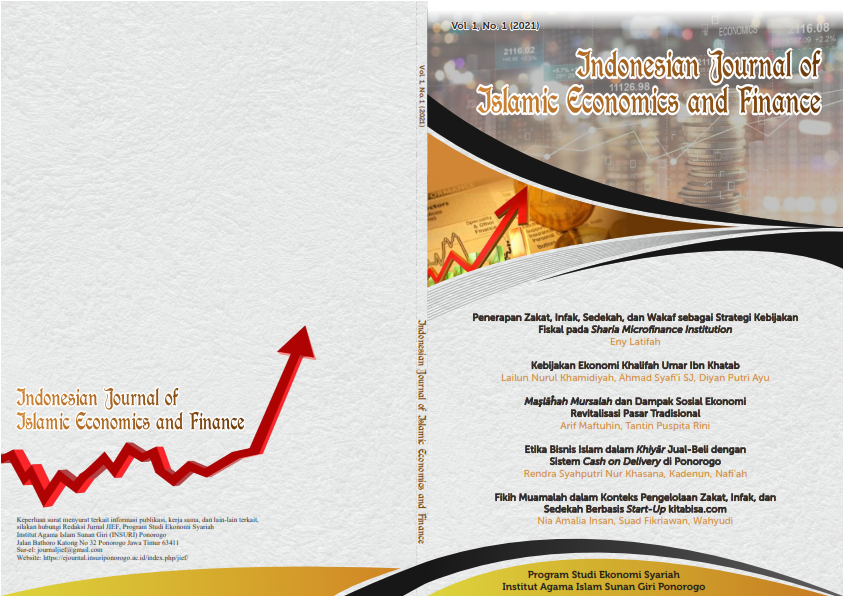Influence Perceived Ease of Use, Perceived Usefulness and Social Influence Against Intention to Use Video on Demand Services at Netflix
DOI:
https://doi.org/10.37680/ijief.v5i1.7090Keywords:
Perceived Ease of Use, Perceived Usefulness, Social InfluenceAbstract
As the number of users of Video on Demand services such as Netflix continues to grow, interest in examining the factors that influence the intention to use these platforms is also increasing. This inquiry aims to explore consumer behavior toward such services from the perspective of Islamic Economics and to analyze the effects of perceived usefulness, perceived ease of use, and social influence on the intention to use Netflix among residents of Sukarame, Bandar Lampung. A quantitative approach was employed, using purposive sampling to select 96 respondents. The data were analyzed using the Structural Equation Modeling Partial Least Square method. The discoveries indicate that all three independent element s perceived usefulness, ease of use, and social influence have a positive and significant impact on the intention to use Netflix. These outcomes can serve as a valuable reference for service providers seeking to improve user experience and for scholars conducting further research on technology adoption within an Islamic framework.
References
Amaral, M. A. L., & Watu, E. G. C. (2021). Pengaruh Performance Expectancy, Effort Expectancy, Social Influence Dan Trust Terhadap Niat Berkelanjutan Menggunakan Fdas Pada Masa Pandemi Covid-19. Sebatik, 25(2), 562–570. https://doi.org/10.46984/sebatik.v25i2.1510
Aminda, A. A., Basrah, S., & Aditya, S. (2022). Analisis Faktor-Faktor yang Mempengaruhi Purchase Intention pada Layanan Subscription Video on Demand (SVOD). Jurnal Bisnis, Manajemen, Dan Keuangan, 3(2), 547–559. https://doi.org/10.21009/jbmk.0302.16
Arsani, A. M. (2024). Aplikasi SmartPLS 4.0 Untuk Statistisi Pemula (Cet 1). Minhaj Pustaka.
Asari, A. (2023). Pengantar Statistika. In Sustainability (Switzerland) (Issue 1). PT Mafy Media Literasi Indonesia.
Ayun, P. K., Purnamasari, F., & Fachry, A. (2024). Pengaruh Persepsi Risiko Belanja Online Dan Electronic Word Of Mouth (E-WOM) Terhadap Minat Beli Secara Online Dengan Kepercayaan Sebagai Variabel Moderasi ( Studi Pada Masyarakat Desa Bandar Negeri Kecamatan. 2, 1283–1310.
Azalia, D. W., & Magnadi, R. H. (2020). Analisis faktor-faktor yang mempengaruhi keputusan pembelian pada layanan video on demand (studi pada pengguna Netflix). Diponegoro Journal of Management, 9(2), 1–12.
Bahruddin, I. (2024). KONSEP MASLAHAH DALAM PEMBANGUNAN EKONOMI UMAT. Al-A’mal: Jurnal Manajemen Bisnis Syariah, 4(II), 119–134. https://ejournal.an-nadwah.ac.id/index.php/Al-amal/article/view/736
Christy, C. C. (2022). FoMo di media sosial dan e-WoM : pertimbangan berbelanja daring pada marketplace. Jurnal Studi Komunikasi, 6(1 SE-Articles), 331–357. https://ejournal.unitomo.ac.id/index.php/jsk/article/view/4446
Cindy Maharani Aulia, Naila Kirani Putri, Shaffa Tanti Yupravita, & Siti Nurmuawanah. (2023). Rendahnya Implementasi Nilai-Nilai Pancasila Bagi Generasi Z Dalam Bermedia Sosial. Hakim: Jurnal Ilmu Hukum Dan Sosial, 2(1 SE-Articles), 225–234. https://doi.org/10.51903/hakim.v2i1.1556
Dalimunthe, N., Rianto, R., & Adawiyah, A. (2020). ANALISIS PENERIMAAN PENGGUNA APLIKASI REVENUE ASSURANCE PEMBENAHAN DATA PELANGGAN (PDP) MENGGUNAKAN METODE TAM. Jurnal Ilmiah Rekayasa Dan Manajemen Sistem Informasi, 6(2), 155–160. https://doi.org/http://dx.doi.org/10.24014/rmsi.v6i2.9553
Fadillah, N. D., Kurniawan, M., & Nurmalia, G. (n.d.). PENGARUH MEDIA SOSIAL , ENDORSEMENT INFLUENCER DAN HARGA TIKET TERHADAP MINAT PEMBELIAN TIKET KONSER ANAK MUDA DI ERA DIGITAL DALAM PERSPEKTIF ETIKA BISNIS ISLAM ( STUDI PADA GENERASI Z DI BANDAR LAMPUNG ) THE INFLUENCE OF SOCIAL MEDIA , INFLUENCER ENDORS. 13(1).
Fariz, M., Wahid, A., Fuadi, F., & Ermawati, L. (2024). The Influence of Perceived Usefulness and Perceived Ease of Use on Intention To Use in Using QRIS According to an Islamic Business Perspective ( Study of QRIS Users at Geprek King Sukarame Restaurant in Bandar Lampung ). 15(4), 706–714.
Gunawan, A., Yunikewaty, Y., & Meitiana, M. (2023). Pengaruh kualitas peelayanan terhadap niat beli ulang melalui kepuasan pada swalayan KPD di Palangka Raya. Media Bina Ilmiah, 17(6), 1185–1194. https://doi.org/https://doi.org/10.33578/mbi.v17i6.243
Hakim, A., Simanjuntak, M., & Hasanah, N. (2021). FAKTOR-FAKTOR YANG MEMENGARUHI KEPUTUSAN PEMBELIAN DI INSTAGRAM: PERAN TRUST SEBAGAI VARIABEL MEDIATOR . Jurnal Ilmu Keluarga Dan Konsumen, 14(3 SE-Articles), 296–309. https://doi.org/10.24156/jikk.2021.14.3.296
Handayani, M., & Rianto, M. (2021a). Pengaruh Financial Knowledge, Pendapatan dan Social influence terhadap Minat Menggunakan Aplikasi Pembayaran Digital pada Generasi Milenial Islam di Kota Bekasi. Jurnal Ilmiah Ekonomi Islam, 7(03), 1858–1865.
Handayani, M., & Rianto, M. R. (2021b). Pengaruh Financial Knowledge, Pendapatan dan Social influence terhadap Minat Menggunakan Aplikasi Pembayaran Digital pada Generasi Milenial Islam di Kota Bekasi. Jurnal Ilmiah Ekonomi Islam, 7(3 SE-Articles), 1858–1865. https://doi.org/10.29040/jiei.v7i3.3620
Humaidi, H., Utomo, S., & Lestari, D. (2022). Pengaruh Persepsi Manfaat, Persepsi Kemudahan Penggunaan Dan Fitur Layanan Terhadap Keputusan Pembelian (Studi Pada Mahasiswa FISIP ULM Di Kota Banjarmasin). Jurnal Bisnis Dan Pembangunan, 11(1), 23–32. https://doi.org/https://dx.doi.org/10.20527/jbp.v11i1.13133
Kabir, M. N. (2019). Strategy, Strategy Formulation, and Business Models BT - Knowledge-Based Social Entrepreneurship: Understanding Knowledge Economy, Innovation, and the Future of Social Entrepreneurship (M. N. Kabir (ed.); pp. 245–280). Palgrave Macmillan US. https://doi.org/10.1057/978-1-137-34809-8_8
Kristiani, N., & Putri, S. W. (2022). Pengaruh Perceived Usefulness Dan Playfulness Terhadap Intention To Use Pengguna Aplikasi Tik Tok Di Masa Pandemi Covid 19. CAPITAL: Jurnal Ekonomi Dan Manajemen, 5(2), 162. https://doi.org/10.25273/capital.v5i2.12021
Kurniawan, M., Restianita, O., & Normasyhuri, K. (2024). Perceived Usefulness , Perceived Enjoyment , Trust dan Continuance Intention dalam Mobile Sharia Banking : Bagaimana Kekuatan Kepuasan Nasabah ? 20(3), 640–657.
Muin, A. (2023). Metode Penelitian Kuantitatif.
NAFIAH, H. (2021). Penggunaan media sosial dalam kehidupan sosial oleh santriwati Pondok Pesantren Universitas Islam Indonesia dalam perspektif uses James Lull. https://dspace.uii.ac.id/handle/123456789/30437
Pasma Sanrawati Sitanggang. (2022). Strategi Pemasaran Global terhadap Netflix. ULIL ALBAB : Jurnal Ilmiah Multidisiplin, 1(9 SE-Articles), 3026–3035. https://ulilalbabinstitute.id/index.php/JIM/article/view/701
Prasetya, A. W., & Lestari, R. (2024). The Influence Of Trust, Perceived Ease Of Use, Perceived Usefulness Through Attitudes On Intention To Use The Gopay Application In The Millennial Generation In South Jakarta. EMBO Journal, 7(5), 2597–5234. https://doi.org/10.1002/j.1460-2075.1995.tb00098.x
Prayogo, M. A., & Hapsari, M. I. (2021). Niat Konsumen Muslim Berlangganan Layanan Video on Demand Bertayangan Islami. Jurnal Ekonomi Syariah Teori Dan Terapan, 8(5), 607. https://doi.org/10.20473/vol8iss20215pp607-616
Purwanto, E. (2020). Technology Adoption A Conceptual Framework MODEL KONSEPTUAL MINAT PENGGUNAAN E-WALLET: TECHNOLOGY ACCEPTANCE MODEL(TAM).
Rahadiyan, R. N., & Hendrawan, D. (2023). Pengaruh Perceived of Usefulnes Perceived ease of use Terhadap Purchase Intention. Jurnal Manajemen Pemasaran Dan Perilaku Konsumen, 2(4), 1088–1097. https://doi.org/10.21776/jmppk.2023.02.4.24
Ridwan, M., Umar, M. H., & Ghafar, A. (2021). Sumber-sumber hukum Islam dan Implementasinya. Borneo: Journal of Islamic Studies, 1(2), 28–41.
Rininda, B. P., & Nurmalina, R. (2023). PENGARUH KUALITAS LAYANAN MOBILE BANKING TERHADAP KEPUASAN NASABAH PT. BANK RAKYAT INDONESIA. JOURNAL OF APPLIED MANAGERIAL ACCOUNTING, 7(2 SE-Articles), 221–229. https://doi.org/10.30871/jama.v7i2.6639
Saputri, H. A. S., Zulhijrah, Nabila Joti Larasati, & Shaleh. (2023). ANALISIS INSTRUMEN ASSESMEN : VALIDITAS, RELIABILITAS, TINGKAT KESUKARAN DAN DAYA BEDA BUTIR SOAL. Didaktik : Jurnal Ilmiah PGSD STKIP Subang, 9(5 SE-Articles), 2986–2995. https://doi.org/10.36989/didaktik.v9i5.2268
Setiawan, J. J. (2020). Pengaruh perceived usefulness, perceived ease of use, subjective norm, dan customer experience terhadap intention to use Mytelkomsel (studi kasus pada mahasiswa Universitas Kristen Petra Surabaya). Jurnal Strategi Pemasaran, 7(1), 12. https://doi.org/https://publication.petra.ac.id/index.php/manajemen-pemasaran/article/view/10193
Sholehuddin, L. (2021). Ekologi dan Kerusakan Lingkungan dalam Persepektif Al-Qur’an. Al-Fanar : Jurnal Ilmu Al-Qur’an Dan Tafsir, 4(2 SE-Articles). https://doi.org/10.33511/alfanar.v4n2.113-134
Subagio, H., & Jessica, J. (2020). Pengaruh Perceived Usefulness, Perceived Ease of Use, Subjective Norm, dan Customer Experience Terhadap Intention To Use My Telkomsel (Studi Kasus Pada Mahasiswa Universitas Kristen Petra Surabaya). Jurnal Strategi Pemasaran (Petra.Ac.Id), 7(1), 1–12.
Sugiyono. (2020). Metode Penelitian Kualitatif Kuantitatif dan R&D. In 2. Alfabeta.
Sulaiman, Y., & Tjhin, U. (2023). Continuance intention to subscribe to a video-on-demand service: A study of Netflix users in Indonesia. Journal of Theoretical and Applied Information Technology, 15(5), 1819–1844.
Suziana, Agriqisthi, & Akbar, L. A. (2024). Pengaruh Content Richness, Perceived Value Dan Social Influence Terhadap Minat Berlangganan (Survey pada Pengguna Aplikasi Vidio di Kota Padang). Jurnal Ekonomika Dan Bisnis (JEBS), 4(1), 79–93. https://doi.org/10.47233/jebs.v4i1.1523
Syahri, A., & Yanita Setyawati, C. (2023). Pengaruh Perceived Ease of Use Terhadap Intention To Use Qris Bca Mobile Dengan Perceived Usefulness Sebagai Variabel Mediasi. Jurnal Keuangan Dan Bisnis, 21(2), 143–151. https://doi.org/10.32524/jkb.v21i2.949
Taopik, I., Supriatna, E., & Yuliani, W. (2023). Uji Validitas Dan Reliabilitas Angket Interaksi Sosial. FOKUS: Kajian Bimbingan Dan Konseling Dalam Pendidikan, 6(4), 278–284. https://doi.org/https://doi.org/10.22460/fokus.v6i4.11060
Triana, N. M. A., & Arif, M. E. (2023). Pengaruh Performance Expectancy, Service Quality, dan Social Influence Terhadap Continuance Intention. Jurnal Manajemen Pemasaran Dan Perilaku Konsumen, 2(3), 717–727. https://doi.org/10.21776/jmppk.2022.02.3.14
Waluyaningtyas, D. P., & Hari Laksana, D. (2023). Pengaruh Perceived Ease Of Use, Perceived Usefulness, Security, Dan Trust Terhadap Intention To Use Aplikasi Access By Kai (Survei pada Mahasiswa di Daerah Istimewa Yogyakarta) . Innovative: Journal Of Social Science Research, 3(6 SE-Articles), 9970–9981. https://doi.org/10.31004/innovative.v3i6.7416
Wiradarma, I. G. N., & Piartrini, P. S. (2022). Understanding Netflix Subscription Intentions Using Technology Acceptance Model: a Study in Denpasar. Russian Journal of Agricultural and Socio-Economic Sciences, 121(1), 37–44. https://doi.org/10.18551/rjoas.2022-01.05
Downloads
Published
How to Cite
Issue
Section
License
Copyright (c) 2025 Tri Novita Sari, Femei Purnamasari, Gustika Nurmalia

This work is licensed under a Creative Commons Attribution-NonCommercial 4.0 International License.
Copyright:
An author who publishes in Indonesian Journal of Islamic Ekonomics and Finance agrees to the following terms:
- Author retains the copyright and grants the journal the right of first publication of the work simultaneously licensed under a Creative Commons Attribution-NonCommercial 4.0 International License that allows others to share the work with an acknowledgment of the work's authorship and initial publication in this journal.
- Author is able to enter into separate, additional contractual arrangements for the non-exclusive distribution of the journal's published version of the work (e.g., post it to an institutional repository or publish it in a book) with the acknowledgment of its initial publication in this journal.
- Author is permitted and encouraged to post his/her work online (e.g., in institutional repositories or on their website) prior to and during the submission process, as it can lead to productive exchanges, as well as earlier and greater citation of the published work (See The Effect of Open Access).
License:
-
Attribution — You must give appropriate credit, provide a link to the license, and indicate if changes were made. You may do so in any reasonable manner, but not in any way that suggests the licensor endorses you or your use.
-
NonCommercial — You may not use the material for commercial purposes.
-
No additional restrictions — You may not apply legal terms or technological measures that legally restrict others from doing anything the license permits.
You are free to:
- Share — copy and redistribute the material in any medium or format
- Adapt — remix, transform, and build upon the material

This work is licensed under a Creative Commons Attribution-NonCommercial 4.0 International License.



.png)







